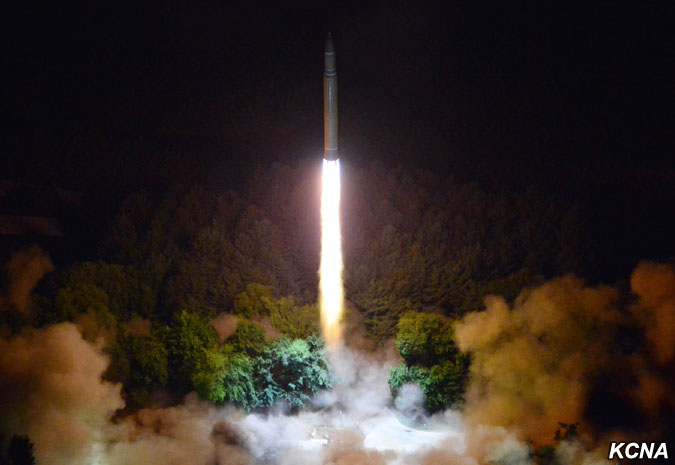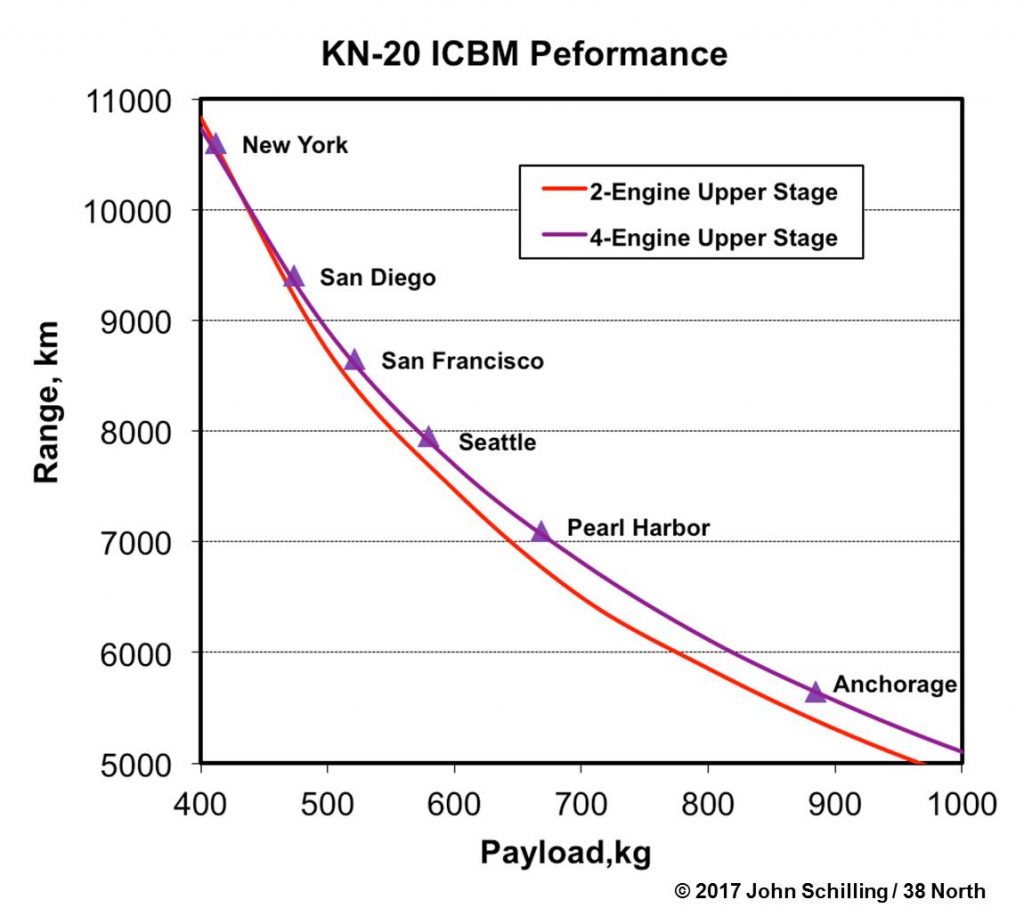What Next for North Korea’s ICBM?
Less than a month after their first successful ICBM test, North Korea has done it again. The missile tested on July 28 appears to be identical to the liquid-fueled KN-20 (Hwasong-14) missile launched on July 4. This missile, however, demonstrated substantially greater range—possibly sufficient to reach the east coast of the United States—but only with a substantially reduced payload. Second, possibly because of the reduced reentry vehicle (RV) weight, the RV appears to have disintegrated before reaching the ground, and thus the test may not have been completely successful. Third, this was the first time the North Koreans have conducted at launch at night, suggesting an emphasis on demonstrating operational rather than experimental launch procedures.
While Pyongyang may have an ICBM, the threat is currently limited to unsophisticated warheads against targets on the US west coast. North Korea will likely have to turn to an upgraded design to achieve their goal of a robust capability to retaliate against targets on the east coast, including Washington, for any attack on North Korea. While the KN-20 may have some deterrent value even in its current, unreliable form, it will likely take another year or two of work to achieve full operational capability. If the North pursues the objective of fielding a new solid-propellant ICBM, that will likely only be another few years beyond that.

The combination of increased performance and a night launch, contrary to North Korea’s hopes, reveal the probable failure of this test. Rather than landing far out to sea, this missile entered the atmosphere within sight of Japan, and it did so in a clear night sky. Several cameras on the Japanese island of Hokkaido caught the incandescent trail of the reentry vehicle. As my colleague Michael Elleman notes, the trail flashes briefly and brightly as the missile descends for 6-8 km, and a second or so thereafter breaks up into at least two visible objects and a vapor trail. The initial flash could be due to the reentry vehicle passing close to a reflective cloud, or it could be a part of the heat shield breaking off and vaporizing. Whatever the cause of the flash, the subsequent breakup is telling. We cannot be certain, but it seems unlikely that a warhead would have survived that experience.
The missile was reported to have reached an altitude of over 3,700 km, remaining airborne for 47 minutes. That’s a substantially higher level of performance than what the missile displayed on its first launch. This means, if the missile had been launched on a maximum-range trajectory, it could have reached Chicago or possibly even New York City. North Korea has given us a clue as to how that happened, with a press release indicating that the number of engines has increased. The trajectory of the first KN-20 indicates that its upper stage was propelled by a set of two vernier engines from an old Soviet submarine-launched ballistic missile whose technology is known to have fallen into North Korean hands. This same propulsion system was used on North Korea’s successful Unha space launch vehicle, but doesn’t produce enough thrust for optimal performance with heavy nuclear warheads. There is room in the upper stage to add a second pair of vernier engines, and we suspect this was done.
But this alone wouldn’t explain the performance observed from the second test. In order to reach a 3,700 km altitude, compared to 2,800 km in the first test, North Korea would probably have needed to reduce the missile’s payload from roughly 500 kg in the first test to 300-350 kg in the second. This may explain the failure. The first test was conducted with a conservative design, with all of the key elements of the missile’s design having been successfully demonstrated in other systems and with a heavy, robust reentry vehicle. The second test included a new upper-stage propulsion system and a much lighter reentry vehicle. The propulsion system worked, but that led to the lighter reentry vehicle hitting the atmosphere at a higher velocity than in the first tests, and that didn’t work so well.
Based on those tests, and on performance data from other missiles whose technology has been incorporated into the KN-20, everything depends on the weight of the payload. 300 kg is almost certainly too small for a reentry vehicle that must carry one of North Korea’s nuclear warheads and survive reentry at ICBM speeds. If they can manage to squeeze a warhead and survivable reentry vehicle into a 400 kg package (a very low possibility), New York might barely be within range. For more realistic 500-600 kg warheads, the KN-20 would be limited to west coast targets. Interestingly, adding extra engines does little to improve long-range performance with the lightest warheads, where the extra thrust isn’t needed and the weight of the engines competes with the warhead. North Korea’s press report alluded to “heavy warheads,” and their chosen missile design supports that interpretation.

If North Korea continues with the current design, their near-term objective will likely be to overcome this latest partial failure in order to field a missile capable of delivering nuclear warheads of reasonable weight to targets on the US west coast. They will presumably want to conduct another test combining the four-vernier engine upper stage and the heavy reentry vehicle to validate that configuration, after which, they may feel ready to go into production and training. And to do that, they may require more tests. The fact that last week’s test was conducted at night and from a site not normally used for missile testing may signal that they are getting a head start on the crew training part already, treating the launch as an operational exercise as well as an engineering test. If they fast-track this version of the missile, they may have a robust, reliable nuclear strike capability against US west coast targets sometime next year, and may have already fielded a few unreliable prototypes to provide minimal deterrence in the interim.
The emphasis on heavy warheads suggests North Korea has plans to use any extra payload capability they can squeeze out of the design. One obvious possibility is a thermonuclear warhead. North Korea has never successfully tested such a device, and the sophisticated designs that allow the major nuclear powers to deliver hundreds of kilotons of yield from a package of only a few hundred kilograms weight are probably beyond Pyongyang’s reach for now. But there are ways for North Korea to incorporate a thermonuclear element to increase the yield of their current 10-20 kiloton fission warheads, and we expect they will seek to incorporate them in any ICBM design they field.
They will probably also seek to incorporate more advanced reentry vehicles, along with decoys and other penetration aids to defeat missile defenses. The successful July 4 test most likely used a simple blunt-body RV, but the payload shroud used on the KN-20 and the post-boost propulsion system demonstrated on the KN-17 (Hwasong-12) would both support a more advanced payload with a low-drag RV[1] and set of decoys. These advances will not come quickly or easily to North Korea, but we should be looking for them perhaps five years down the road.
While North Korea’s ambitions reach beyond the west coast to places like Washington, DC, if they want to accomplish that with this missile, they will have to change the design substantially. The extra engines on the upper stage currently aren’t enough; they will also need to stretch the propellant tanks. Additionally, they will need to demonstrate a lightweight warhead capable of surviving the faster and hotter reentry of such a long-range missile. This missile’s design may not stretch that far without breaking, but North Korea may try anyway. If so, they probably won’t succeed this year or next.
They may not try at all. Earlier this year, canisters representing solid-propellant ICBMs were paraded through the streets of Pyongyang. Those canisters were probably empty; North Korea has an ambitious solid-rocket development program but has so far only been able to build smaller medium-range missiles using solid propellant. But the greater mobility and responsiveness afforded by solid propellant makes it the clear choice for ICBMs as well. North Korea may consider the liquid-propellant KN-20 to be strictly an interim system to provide limited deterrence by threatening US west coast targets and to support technology development for advanced warheads and other systems to be incorporated in a new solid-propellant ICBM in perhaps 2025.
The bottom line today is that North Korea has tested two versions of the KN-20 ICBM which seem to work, and two reentry vehicles, one of which probably didn’t work. Using the more conservative RV design, they can field a system that can threaten US west coast targets. At first, this threat will consist of a handful of unreliable prototype missiles, but as early as next year they could begin production and deployment of a proven, reliable design with trained crews. After that, they might be able to stretch the KN-20 design to reach Washington, DC, with a light warhead. Or they might use the system’s increased payload capability at short ranges to experiment with more advanced warheads and decoys, which in the longer term could be incorporated in a new solid-fuel ICBM.
- [1]
Most nuclear powers use narrow, conical reentry vehicles that afford much greater accuracy and are harder to intercept than the blunt or triconic warheads seen on North Korean missiles. Such reentry vehicles require advanced thermal protection systems, beyond North Korea’s capabilities for now, but probably not forever.
